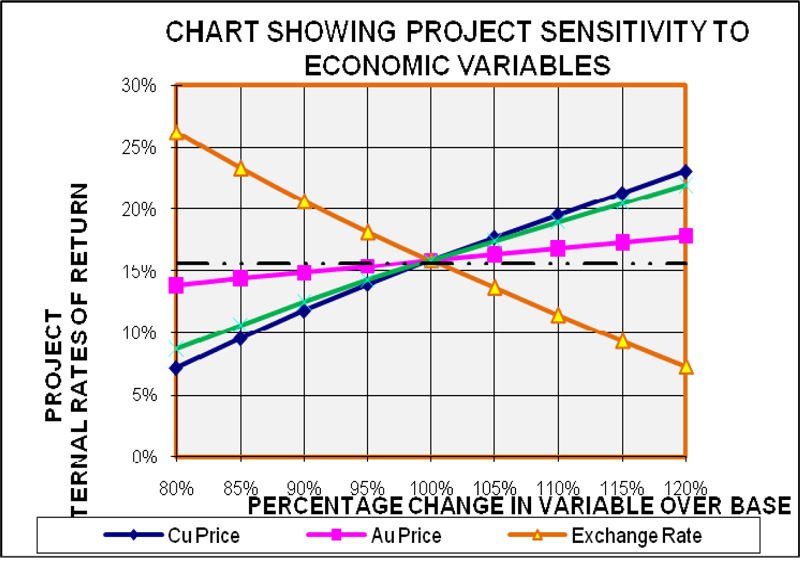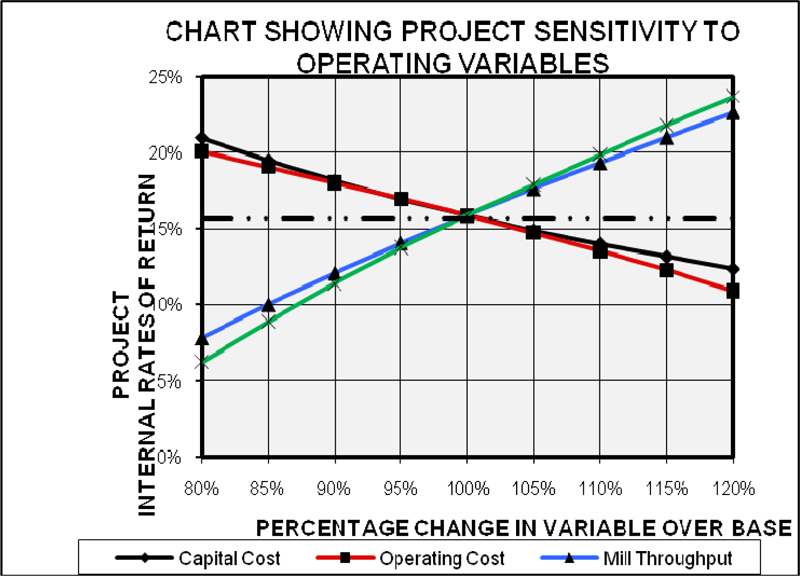Vancouver -
November 16, 2010 - Imperial Metals Corporation (III-TSX) has completed an update of the
Red Chris Copper-Gold Project Feasibility Study Report dated March 2005 (the “2005 Feasibility”) prepared by AMEC Americas Limited (“AMEC”). Imperial’s
Red Chris 2010 Feasibility Study Update (the “2010 Update”) is intended to guide development of the project within its current Provincial and Federal Approval framework and does not take into account the results deep drilling carried out by Imperial.
The 2010 Update indicates an after tax internal rate of return (“IRR”) of 15.7% at metal prices of US$2.20/lb copper and US$900/oz gold and a capital cost of C$443 million.
The 2010 Update uses the mining envelope, mining rate and metal recovery estimates used in the 2005 Feasibility. The block model used was from the
Red Chris Deposit Technical Report: 2010 Exploration, Drilling and Mineral Resource Update dated May 19, 2010 (the “2010 Technical Report”). The 2010 Technical Report was prepared in accordance with National Instrument 43-101 and is available on
www.imperialmetals.com and
www.sedar.com.
Highlights of 2010 Update
- Reserves of over 300 million tonnes grading 0.359% copper and 0.274 g/t gold provide for a 28 year project life at a milling rate of 30,000 tonnes per day.
- Pre production period of only four months during which 1.8 million tonnes of rock and overburden would be relocated. The Red Chris orebody is exposed at surface resulting in a comparatively limited pre production phase.
- Recovered metal in concentrate would total 2.08 billion lbs copper and 1.324 million oz gold.
- After tax IRR of 15.7% at metal prices of US$2.20/lb copper, US$900/oz gold, US$12.00/oz silver, and exchange rate of CDN$1 to US$0.90. Project payback is 4.58 years. Life of mine production cost per pound of copper at these prices, taking silver and gold as credit, is US$1.22. Capital cost is C$443 million
- At the October 2010 monthly average metal prices of US$3.76/lb copper, US$1342.60/oz gold, US$23.39/oz silver, and an exchange rate of CDN$1 to US$0.982, the project IRR after tax is 37.9%. The project payback is 1.87 years. Life of mine production cost per pound of copper at these prices, taking silver and gold as credit, is US$1.15.
Summary of 2010 UpdateThe project is the development of an open pit mining and milling operation. The mining fleet would include 311mm electric rotary drills, 28m³ hydraulic excavators, 230 tonne capacity haul trucks and associated support equipment.
Other mining fleet options under consideration include diesel powered hydraulic drills and electric cable shovels. Ore would be fed to a 1.3m x 1.8m gyratory crusher for crushing to a nominal -150mm. Crushed ore would be held in a 120,000 tonne capacity intermediate stockpile before recovery to the plant.
Plant design is based on a standard porphyry copper flow sheet employing SAG and ball milling, flotation, regrinding, thickening and filtering to produce a concentrate for export averaging 27% copper at a moisture content of 8%. The grinding circuit would include a 10.36m x 4.72m x 11,200kW SAG mill feeding two 5.79m x 8.84m x 5,600kW ball mills providing a primary grind of K80 of -150µ. Coarse rejects from the SAG mill would be crushed in a 600kW pebble mill. Ball mill discharge would feed two banks of 5 x 100m³ rougher flotation cells followed by a bank of 5 x 50m³ cleaner cells. Cyclone underflow would be fed to two 932kW tower mills to provide a K80 of -24µ. The primary and regrind product sizes were determined by G&T Metallurgical Services Ltd. to provide the optimum conditions for copper recovery and concentrate grade. Concentrate would be thickened and filtered and then loaded on B-Train trucks of nominal 50 tonne capacity for hauling to the Port of Stewart for shipment to smelters in the Pacific Rim.
Rock management has been designed to minimize the impact on the environment. Rock from the open pit would be stacked to the north where topography allows any runoff to be directed to the open pit and the tailings storage facility for collection. Low grade material would be stockpiled to the northeast of the pit, just to the north of the primary crusher for easy reclaim later in the mine life. The tailings impoundment area would be located in a valley to the northeast of the plant. The Company has presented a fish compensation plan to the Department of Fisheries and Oceans Canada for approval and recommendation to Environment Canada for commencing Metal Mining Effluent Regulations Schedule 2 Designation of the tailings impoundment area.
Plant infrastructure would include upgrade of the existing temporary road and an extension to a 23 kilometre access road from Highway 37 near Tatogga Lake, a 250 person camp, equipment maintenance shop, warehouse, administration office, satellite communication for voice and data, and explosives storage and/or manufacturing facility and magazines.
The project assumes power would be supplied by an extension to the Northwest Transmission Line from Bob Quinn. The project capital includes the cost of building a 115 kilometre power line from Bob Quinn north along Highway 37 and then branching off to the mine site following the mine access road.
Mine capital costs have been based on the purchase of all new equipment. All shovels, drills, haul trucks, dozers and graders would be equipped with fleet management systems to improve safety and efficiency.
The project would employ approximately 300 hourly, salaried and contract personnel, and would operate on a fly-in/fly-out basis on a two week rotation. Chartered aircraft would fly employees to the Dease Lake airstrip from where they would be bused to the project site.
Following exhaustion of reserves, the project would close and be reclaimed. All equipment and facilities would be removed and the area graded and seeded, the rock storage areas and dam walls covered in till and seeded, drainages constructed so any effluent from the rock storage areas would be directed into the open pit for collection. Provision would be made for a water treatment plant to recover metals, including copper contained in any effluent from the open pit once it eventually fills with water after completion of mining operations. The water treatment plant would be designed for self sufficiency with the value of recovered metals covering the operating and sustaining capital cost of the plant. The project capital cost includes funding for a surety bond to guarantee future reclamation obligations.
The project obtained BC Environmental Assessment Certificate in 2005, which was extended in July 2010, and obtained Canadian Environmental Assessment Act approval in 2006, which was confirmed by the Supreme Court of Canada in January 2010 following a third party challenge. In July 2010 the Company submitted a Joint Application for the Mines’ Act Permit and the Effluent Discharge Permit under the Environmental Management Act.
Estimation Reserves and ResourcesThe Red Chris copper/gold deposit has several identified mineralized zones. The 2010 Update uses the same ultimate pit shell, covering the Main and East zones, developed using a Lerchs-Grossman algorithm in 2005. However, the ultimate open pit was redesigned for the 2010 Update to eliminate irregular bench features and include a detailed and practical smoothed pit design with ramps. The more linear pit walls would improve the overall wall stability and ease construction. The ore reserves were updated using the computer generated block model in the 2010 Technical Report.
Mineable Reserves and Mineral ResourcesThe mineable reserves estimate in the 2010 Update for the pit shell designed in 2005 are provided below, and are all contained within the upper portion of Main and East zones.
|
|
Tonnes
|
Cu %
|
Au g/t
|
| Proven and Probable
|
301,549,000
|
0.359
|
0.274
|
The Red Chris property hosts significant mineral resources. The resource for the measured and indicated category and the inferred category, a copper cut-off grade of 0.10% of the entire property, including all zones of mineralization, are provided below. The estimated resources at different categories and cut-offs are documented in the 2010 Technical Report which includes a full description of the estimation method and the sampling, assaying and QA/QC procedures.
| 2010 Technical Report
|
|
| Measured and Indicated
|
|
| Tonnes
|
619.42 M
|
| Cu %
|
0.38
|
| Au g/t
|
0.36
|
| Contained lbs copper
|
5.14 B
|
| Contained oz gold
|
7.16 M
|
| Inferred Mineral Resource
|
|
| Tonnes
|
619.13 M
|
| Cu %
|
0.30
|
| Au g/t
|
0.32
|
| Contained lbs copper
|
4.12 B
|
| Contained oz gold
|
6.43 M
|
Risk AssessmentThe estimates of mineral resources and mineral reserves have been prepared and calculated internally by Art Frye, Mine Operations Manager for Mount Polley Mining Corporation, and by Greg Gillstrom, P.Eng, Senior Geological Engineer with the Company, designated as the “Qualified Person” as defined under National Instrument 43-101 for the resource calculation.
The determination of mineral resources for the Red Chris property has been based on the results of data from exploration drill programs conducted between 1974 and 2009 with data from 365 diamond drill holes.
Since 2005 several geotechnical studies have been completed. In 2010 AMEC Earth and Environmental was commissioned to complete a detailed site investigation and design of the proposed tailing storage facility. The majority of this work is now complete, and the findings have been incorporated into the 2010 Update.
The 2010 Update has taken the results of the 2005 Feasibility and updated the capital and operating costs. The pit is essentially as designed in 2005, with some minor smoothing, and mineable tonnage and grades have changed slightly reflecting the current cost and price regime, and the results from additional drilling. Metallurgical recoveries and plant design remain as in the previous study. The project is dependent on the completion of a 335 kilometer long 287kV transmission line, the Northern Transmission Line, an initiative to bring the electricity grid to northwest British Columbia.
Changes in metal prices, operating costs, exchange rates, transportation and shipping costs, smelting and refining costs, taxation, legislation could individually or collectively have a material impact on the reserves to the point where the project could become uneconomic. The project also needs to complete further permitting requirements before construction or operation of the mine can begin.
The following charts demonstrate the sensitivity of the project’s IRR to changes in copper and gold pricing, CDN/US Dollar exchange rate, capital and operating costs, mill head grade, mill recovery, and mill through-put. The project’s IRR is most sensitive to changes in copper price and the CDN/US Dollar exchange rate, and less so to gold price and capital cost.

 National Instrument 43-101 Compliance
National Instrument 43-101 ComplianceThe 2010 Update to the 2005 Feasibility used the computer generated block model described in the 2010 Technical Report, which was prepared in accordance with the guidelines of National Instrument 43-101.
Details on the methodology used to create the block model are described in the 2010 Technical Report, available on
www.imperialmetals.com and
www.sedar.com. Additional details relating to the 2005 Feasibility are provided in the National Instrument 43-101 compliant
Technical Report on the Red Chris Copper-Gold Project December 16, 2004, filed by bcMetals Corporation, available on
www.sedar.com.
Operating costs for the 2010 Update have been prepared by Imperial staff, utilizing cost information from similar mines in British Columbia operated by the Company. Merit Consultants International Inc. has prepared the capital cost estimate for the 2010 Update, except for the mining area costs which were estimated by Imperial staff. Merit completed the cost estimate for the 2005 Feasibility and thus had a thorough knowledge of the project. Revised quantity take-offs for the earthworks in the tailings storage facility were supplied by AMEC Earth and Environmental based on its 2010 site investigation and design work.
Contact: Brian Kynoch, President 604.669.8959; Raj Anand, Manager Project Development 604.488.2673;
Sabine Goetz, Investor Relations 604.488.2657 // website:
www.imperialmetals.com // email:
info@imperialmetals.com
Back to the Press Releases page

